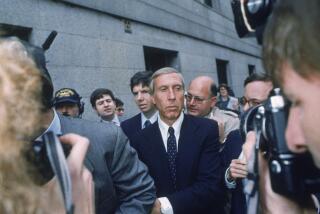Former trader marks Lehman’s collapse as a second chance
- Share via
Reporting from New York — Three years ago, global markets were plunged into chaos when Lehman Bros. collapsed at the height of the financial crisis. Jared Dillian, an ex-trader at the firm, is just happy to have gotten out alive — literally.
Dillian’s seven years as a Wall Street trader came to an end when the 158-year-old firm was dramatically pushed into bankruptcy Sept. 15, 2008. He’ll mark the anniversary as a rare second chance in life after the high-pressure job turned him into a sort of voodoo doll on which the financial industry’s wounds were visible.
As Lehman Bros. was heading toward implosion, the traders who sat near Dillian began noticing strange routines he had added to the end of each day. Instead of heading out to the bar after the markets closed, Dillian would stay for 30 minutes, manually logging out each of his three computers in the same order. After making it down the elevator, he would frequently race back up to make sure he had not missed a step.
With each passing day, Dillian’s anxiety grew — and with it the number of obsessive compulsive rituals his mind created — as Lehman’s troubles appeared to spiral out of control, an experience he documents in his book, “Street Freak,” released this week.
“The whole purpose of an anxiety disorder is to distract your mind from thinking about a problem you should be thinking about,” Dillian said recently. “In my case, that problem was Lehman.”
There have been other books written about Lehman. But this one has Wall Street buzzing: It lays out the personal experience of a trader battling bipolar disorder while the financial system breaks down around him.
From the start, Dillian was always a bit of an unlikely fit for Wall Street.
Unlike the Ivy League-educated recruits that Goldman Sachs and Morgan Stanley tended to favor, Dillian had received his MBA at night from the University of San Francisco while serving during the day in the Coast Guard.
Lehman Bros., though, had a reputation for taking scrappy fighters like Dillian and harnessing their raw energy. Even its then-chief executive, Richard Fuld, was nicknamed “the gorilla” for his intimidating presence.
At one of his first interviews with Lehman, Dillian said: “Nobody is willing to put in the hours that I will put in. I am insane.”
Dillian learned that what Lehman liked was the aggression that came naturally to him. When he lost one big trade, he slammed his phone handset down so hard it shattered. He quickly was offered two different promotions.
Richard Gatward, who sat 20 feet away from Dillian, said his co-worker’s brilliance, as well as his tempestuousness, was obvious.
“The trading floor is kind of a rambunctious place, but sometimes the floor would just stop when Jared was screaming his head off at someone or something,” Gatward said.
Before long, Dillian found himself at the heart of Wall Street’s steaming money machine after being elevated to Lehman’s head trader of exchange-traded funds. The investments, known as ETFs, are a sophisticated type of financial instrument that allows a whole basket of stocks to be traded simultaneously.
He was put in front of three computers with five screens and given responsibility for tens of millions of dollars each day. At the end of the year, he would be handed a slip of paper with his performance bonus: One year it was $650,000, the next, $675,000.
During those boom years in the middle of the last decade, Lehman and other investment banks were channeling billions of dollars into subprime mortgages and then turning those mortgages into sophisticated financial instruments that were sold to often-unwitting investors.
It created billions in profits, but it also put an increasing strain on the entire financial system, as well as the traders doing the work. Dillian would become ecstatic when he managed to beat another trader and then fall into fury when trades went against him.
Gatward said Dillian was not the only one to buckle under the pressure.
“You’re literally going in and getting beaten up every day,” Gatward said.
For Dillian, though, it was more serious than cold sweats and anxiety — even in the seemingly best of economic times. He became paranoid that regulators were coming after him. He refused to answer the phone and would break into uncontrollable sobs at his desk. At one point, he tried to commit suicide but could only find half a bottle of Tylenol PM to swallow.
Dillian retells one story when he was at his desk in 2006, ready to trade, but after making a big purchase, his hands froze as its value began plummeting. “I just watched it go lower and lower and lower, and I couldn’t do anything — and I never did,” Dillian said.
He looked up the number of a psychiatrist, called for an emergency appointment and walked out the door with his trade still open. The psychiatrist immediately put him in a locked ward, where he was diagnosed with bipolar disorder.
With the diagnosis in hand, he saw the signs of the disease everywhere in his past. In the Coast Guard and later at Lehman, he would work days at a time with little sleep and frequent emotional swings.
It’s just that on Wall Street, his mental distress blended in.
“People were sure I was absolutely nuts in the Coast Guard, and then I get here and that kind of behavior is not only OK, it is encouraged,” Dillian said, sitting in a New York coffee shop.
He took the first steps of recovery while in the hospital for three weeks. On a whim, he attended a writing workshop with the other inpatients and found he had a natural talent.
The volunteer teacher of the workshop, novelist Siri Hustvedt, said she was struck by his writing’s mix of “edginess and confidence,” and asked him if he had ever considered becoming a writer.
When he finally returned to his job a month later, his colleagues were welcoming and warm, and he developed a sideline in penning long notes about the market’s behavior.
But he also got pulled back into Wall Street’s toxic grind just as the mortgage meltdown in early 2008 triggered the financial crisis.
The pressure didn’t bring back his bipolar disorder — lithium had taken care of that. But his obsessive compulsive disorder picked up. Each morning when he left his house he would spend an hour making sure all the windows were closed and appliances turned off, locking the deadbolt five, then six times.
These mental tics only came to an end once Lehman declared bankruptcy, and he was free of the trading floor.
Last year, two years after Lehman’s collapse, he and his wife left New York for a home near the beach in South Carolina. It was only once he was gone that he saw the strain city life had put on him.
Being back in New York during the recent market swings, he was reminded of the days when Lehman was teetering on the edge and he would come down from the trading floor to find the world in one piece.
“I’d walk outside and the tourists were all happy, and there were cabs and street vendors, and it seemed like these people just didn’t get it, that the world is coming to an end,” he said.
With his new perspective, though, he can see that he was the one who didn’t get it: “The point is that the world really doesn’t come to an end.”
More to Read
Inside the business of entertainment
The Wide Shot brings you news, analysis and insights on everything from streaming wars to production — and what it all means for the future.
You may occasionally receive promotional content from the Los Angeles Times.










